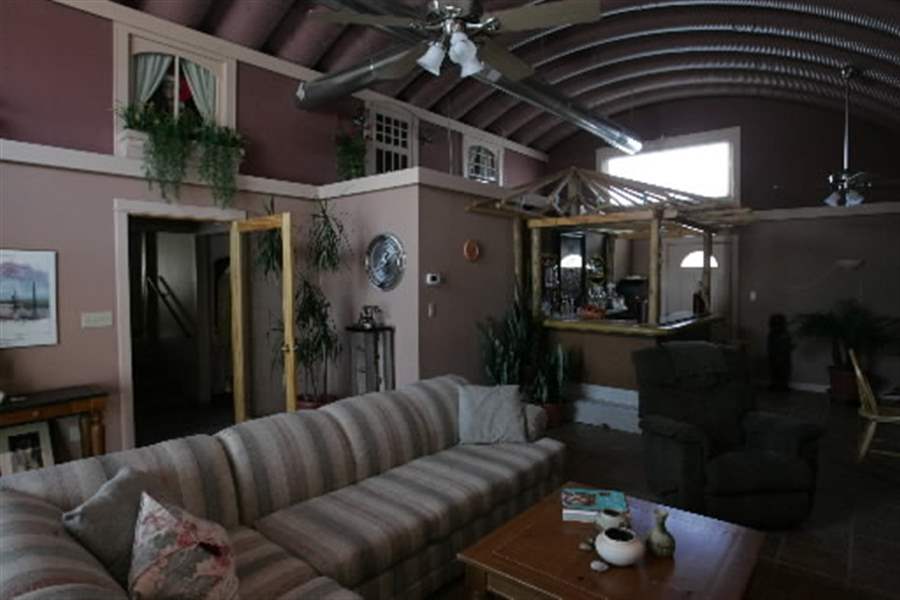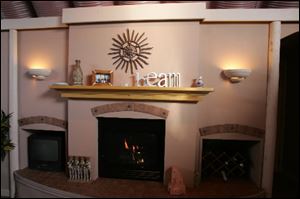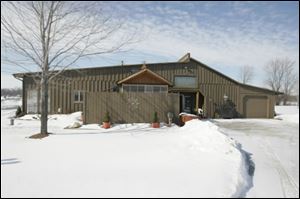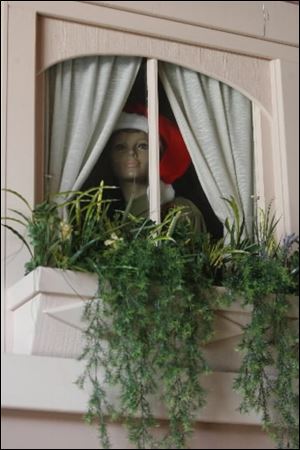
Couple and their family transform steel building into a welcoming house
2/22/2009
The ceiling of this old quonset is 20 feet at the apex. <br> <img src=http://www.toledoblade.com/assets/gif/TO1599743.GIF> <b><font color=red>MULTIMEDIA:</b></font color=red> <a href=" http://advertising.toledoblade.com/newsroom/newShowroom/index.html" target="_blank "><b> Sweet Homes: Sweet Showroom</b></a> (Feb. 22, 2009)
The Blade will periodically feature intriguing homes and gardens that reflect the creativity of their owners. Tell us about your abode by writing Tahree Lane at tlane@theblade.com or calling 419-724-6075.
The plan was to be happily homeless, living in a motor home moored in an Ohio campground most of the year and in the Southwest during the winter.
And for seven years they were home free.
It was nice. We found that we lived outside most of the time. We cooked on the grill. Sleeping was about all we did inside, said Mary Beam. She and Ronald, her husband of 55 years, enjoyed the gypsy life.
We met a lot of people who lived like that.
She d had jobs at Bowling Green State University, at their Ohio campground, and elsewhere; Ron had been a truck driver until a 1975 heart attack, and then they both worked for a small all-terrain-vehicle company.
By 1995, Ron s heart condition had worsened. He required heart bypass surgery.
We didn t have a home and it was scary, Mary said.
They were in their early 60s and living on a tight budget. While Ron recuperated, they stayed in an efficiency apartment her sister owned. One of their six children, Mike Beam, had an idea.

The room's Southwest theme is carried through in the mantel decorations.
He had recently completed 10 years with the U.S. Air Force and with his wife, Debi Beam, had purchased a ranch-style home three miles east of Woodville in western Sandusky County. The property included a vacant building that had been a recreational vehicle sales showroom and repair shop. Painted barn red, it was an odd geometry facing busy State Rt. 20: the back where campers were fixed was a really ugly steel quonset hut dating to the 1950s, said Mike. In front, the showroom was
one story, its sloping roof centered with a steep A-frame structure hovering over the front door. The floor was concrete.
Mike and Debi had dreamed of turning the place into a craft store, but after his father s surgery, he figured it could be transformed into a cozy retirement home. If his parents would purchase supplies, he d provide free labor.

The former showroom's side is the home's main entrance. A garden and seating area is behind the fence.
We were both hesitant at first, said Mary, 76. It would mean spending a sizable portion of their nest egg.
But it didn t sound crazy. Not if you know Mike, she said.
When he was 15, Mike drew detailed plans for a breezeway and garage at the family s then-home in Woodville, from which the contractors worked. He had also remodeled several homes, including his current one. But Mike, who looked at the vacant building every day, knew it would take a lot to turn a sow s ear into a silk purse.
Looking at the building you d go What are you thinking?
In 1996, he designed a small kitchen-dining area, a living room, bedroom, and bath in what had been the camper showroom: it would be cheap to heat and maintain, and relatively roomy for a couple accustomed to the close quarters of an RV.

Miss Kitty the mannequin is a party-room feature.
We aren t fussy, Mary said.
She liked high ceilings (they re 8, 12, and 20 feet in various spots), but didn t want the beams he suggested across the ceiling in the living room, where they watch a movie every afternoon. Ron wanted to retain the showroom s large front windows.
The old building s lack of water proved to be the biggest challenge for Mike, 48, who works in heating, ventilation, and air conditioning. They drilled for 120-feet before striking good water. To allow for plumbing, he had to raise the floor four feet to construct bathroom, bedroom, and kitchen, resulting in a few stairs up and down in the middle of the house.
The six Beam offspring, ages 48 to 53, and several of their spouses pitched in on projects and painting. By early 1997, Mary and Ron were in. They had a like-new home for about $29,000.
The walls are covered with what Mary calls Beam paint, a mix of leftovers that s a pleasing taupe.
A gleaming black-tile floor in the kitchen that seemed like a stunning idea has since been replaced with blond wood it showed every crumb and speck. Kitchen counters are still unforgiving black, as is the floor in the bathroom, for which Mary changes the towel-and-rug scheme every season. Mike purchased kitchen cabinetry without drawer pulls and white-washed them to a light shade Mary preferred.
Phase II
The simple, versatile quonset hut, built by the tens of thousands during World War II and used for everything from sleeping quarters to munitions storage, was modeled after the British Nissen hut of World War I. Following World War II, the U.S. government sold them cheap, and a few manufacturers continued producing them mostly for industrial and agricultural use.
Mike said he doesn t know whether theirs is World War II vintage, but the steel is thick and strong, creating the kind of space he d want to be in during a tornado.
Two years later, Phase II involved framing over the exposed back half of the quonset with sturdy, never-painted boards from an 1890 barn a friend of Mike s had torn down. The trade: two trailer loads of one-by-six and one-by-eight boards in exchange for Mike constructing a 30-by-40-foot deck for his friend.
The entire exterior was repaired and the house was painted brown. Little by little, they landscaped, adding flower circles and a tall lamp.
Room for family
With all 23 offspring nearby, the Beams have lots of visitors. Moreover, Mary s always thinking up ways to bring people together. She organized a water aerobics group last summer, using Mike s above-ground pool. She wants to start a weight-loss/walking group for friends and family on Sundays. She loves cookbooks. That s why I have to go on a diet, she said.
As they shed their gypsy lifestyle, the Beams found themselves entertaining more. Because everyone s so close we visit back and forth, she said. They wanted more room and the old quonset hut in the rear, used for tools and storage, was the ticket.
With Mike at the helm, they launched Phase III in 2006. One area would be boxed in to become a bookshelf-lined study and a hallway for the main entrance, both with dropped ceilings.
The other area would be spacious and fun with bar, fireplace, and a Southwestern feel. The final portion of the hut would be a garage.
The new study is Mary s first-ever room of her own her sanctuary for reading (politics, history, essays), watching favorite TV shows, and writing (she created a book about the late Buford Beauregard, their 168-pound, black labrador/St. Bernard who was killed by a car three years ago).
I grew up in a family of six children and then I had six children. And when you re living in a camper you don t have anything of your own, she said, noting that she shares the computer with Ron.
Place for parties
But it s the party room that really sets this home apart. Arching corrugated steel, 20 feet at its apex, looks like fat, reticulated coils. Mary wanted to keep it exposed. After a power washing, a coat of plum-colored etching paint was brushed on. A heating duct was stretched across the top. A couple of light fixture/fans were suspended.
The 12-foot wall separating this room from the rest of the house has two tiers. The top four feet stretching down from the steel ceiling includes three decorative windows and a small door. Behind one curtained window peeks Miss Kitty, a mannequin Mary dresses for each season. Fern-filled flower boxes in front of the windows lend the room an outdoor feel.
The bottom eight feet of wall is a desert-sand color and texture, topped by a lighter-colored ledge to match the moldings.
There s a good sized wooden bar that s been in one family member s home or another for years, steer horns hung with hats, a teal-colored cactus coat hangar. A crisp fireplace is flanked by two adjacent cubbies, one snug with a TV, the other with bottles of wine. An arch of tile is above each opening and above that, a sleek wooden mantel.
The brown tile floor was painstakingly and painfully (their knees protested mightily) installed by sons and daughters-in-law in one long weekend.
The cost for Phase III: $30,000.
Other niceities have been added.
A fenced-in veranda just outside the main entrance is full of flowers and potted plants in the warm months, a fish pond, a swing, table, chairs, and a grill. Their kids bought them a new furnace that sliced their heating bills in half, and last Christmas gave them a heat pump. One Sunday the kids gathered for a picnic and built a picket fence Mary had requested around the old apple tree that provides grist for many jars of applesauce.
A morning deck may be added off the far side of the party room. There s always a project, Mary said.
Our whole life has been about change and adventure.